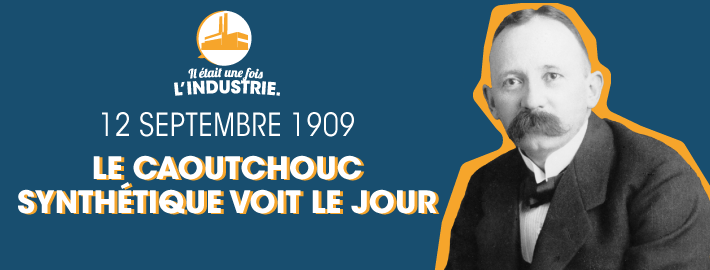GLOBAL
INDUSTRIE
News
Share on

12 September 1909: synthetic rubber is born
What happened this week in the History of Industry? It is to answer this question that Global Industrie invites you to rediscover, every week, a historical event which occurred around this time… in another age. Today, let’s take a closer look at a German chemist, Fritz Hofmann, who filed a patent for the first synthetic rubber on the 12th of September 1909. The (en)tire story…
PLASTIC IS FANTASTIC, BUT RUBBER’S SUPER TOUGH
When Fritz Hofmann was born on the 2nd of November 1866 in Kölleda, Germany, rubber and its numerous benefits had been known for many centuries.
Did you know, for example, that in Central America the Mayas and the Aztecs used latex from rubber trees to make balls and waterproof their canoes? It was not until 1736, however, that a French naturalist, Charles Marie de La Condamine, rediscovered it in Peru and understood the tremendous potential of natural rubber. It was he moreover who gave rubber its French name “caoutchouc”, formed from two native words and literally meaning "crying wood".
For nearly a century however, its use remained limited due to its problems of resistance to temperature variations: it hardened under the effect of cold and became viscous when it was hot… Until the beginning of the 1840s when the American Charles Goodyear observed that rubber treated with sulphur - "vulcanized" – withstands temperature variations.
From that point on, its production exploded, particularly due to the development of the motor car. The only problem was: its price also skyrocketed! In 1906, the German firm Bayer therefore put up a sum of 20,000 marks which would be awarded to the chemist who could manufacture an equivalent of natural rubber for less than 10 marks per kilogram…
AND THE WINNER IS…
This was where Fritz Hofmann stepped in. After studying pharmacy in Berlin, he turned to chemistry and obtained his doctorate brilliantly at the University of Rostock. He then conducted research simultaneously on pharmaceutical products and synthetic rubbers. It was thus a confirmed chemist who won the coveted prize by developing a polymer derived from oil, less flexible but considerably stronger than natural rubber, for which he filed a patent on the 12th of September 1909. Other versions were to follow, constantly improving performances.
Nowadays, synthetic rubber is present everywhere due to its unique properties. It is elastic and can be stretched to ten times its size without being deformed and retain this property down to a temperature of -50°C. An insulator and sealant, it is impermeable to air, water, gas and even noise. It is also strong, absorbing shocks and damping vibrations. Its applications are numerous: seals, wrist straps, tires, roof coverings, etc. All of these qualities make it particularly precious in industry in general and in the transport industry in particular, for automotive, railway, aviation and even aerospace applications.
And Fritz Hofmann in all of this, you may ask? By the time he departed this world on the 22nd of October 1956, at the age of nearly 90, he had received recognition from his peers both through the positions he subsequently held and through the decorations he received. Which were certainly not made of rubber!
"There are so many twists and turns in my books you’d think they were made of rubber" – Frédéric Dard
OTHER EVENTS WHICH HAPPENED THIS WEEK:
- 7 September (1804): the Italian aeronauts Zambeccari, Andreoli and Grassetti fly over the Adriatic in a balloon
- 7 September (1882): the American inventor Edison lights up an area of New York for the first time with electricity
- 9 September (1975): take-off of the American Mars probe Viking 2
- 10 September (2008): CERN’s Large Hadron Collider, the most powerful particle accelerator in the world, is placed in operation
- 11 September (1917): Georges Guynemer dies in aerial combat
- 12 September (1962): JFK delivers his We choose to go to the Moon speech in which he promises to see an American set foot on the Moon before the end of the 1960s
- 13 September (1994): in Toulouse, first flight of the Airbus Beluga, the largest jumbo jet in the world
2020.09.09